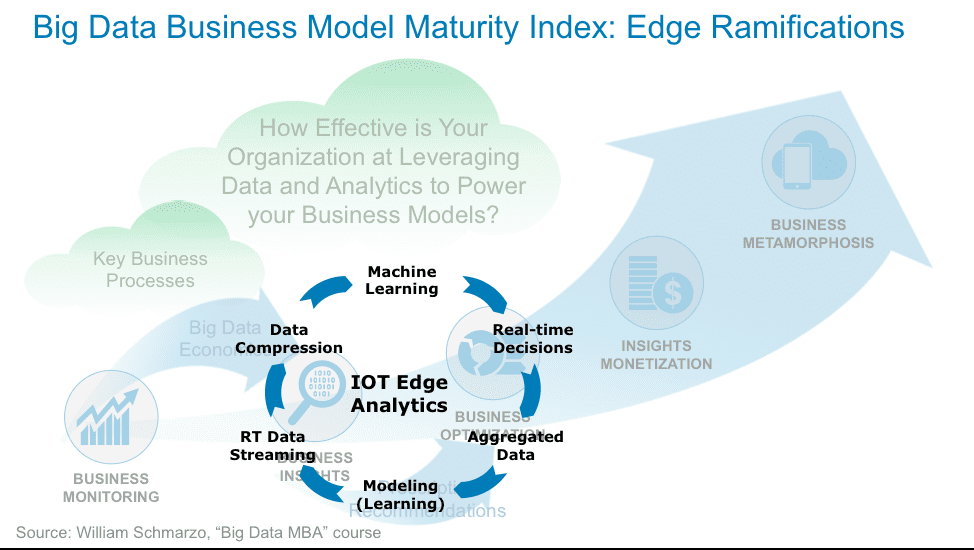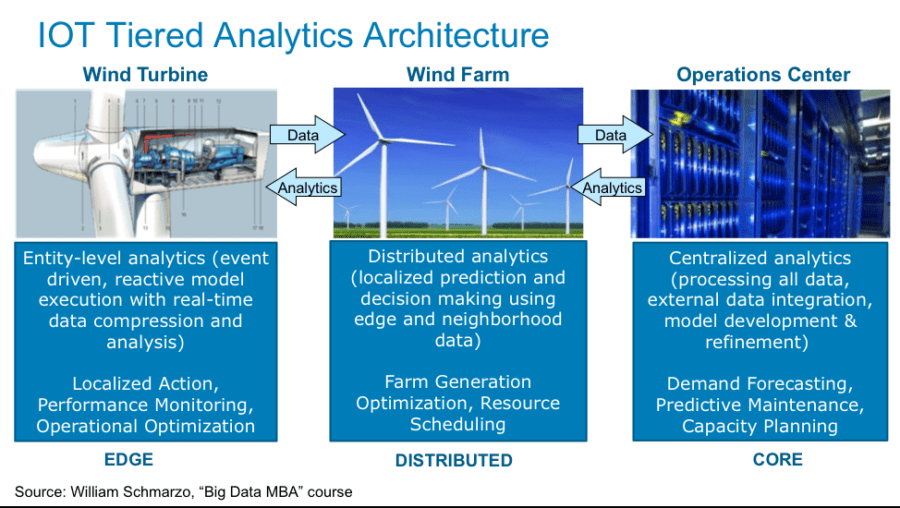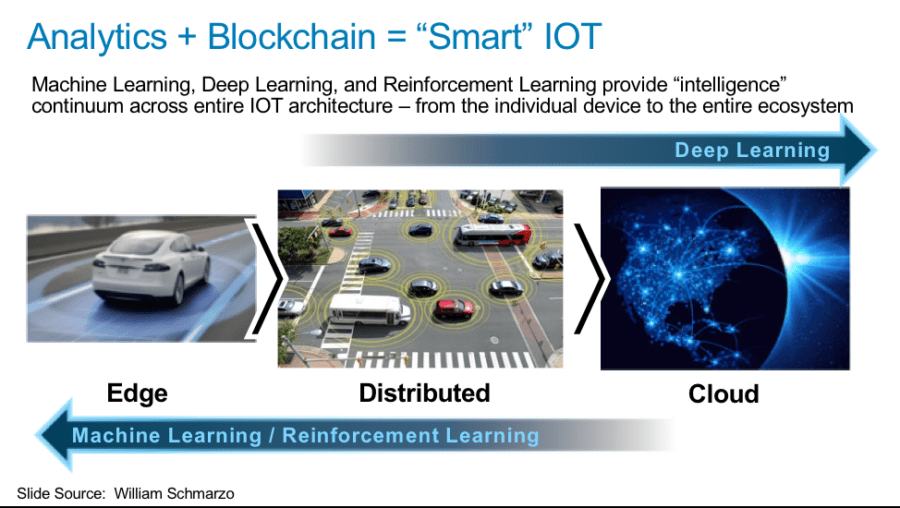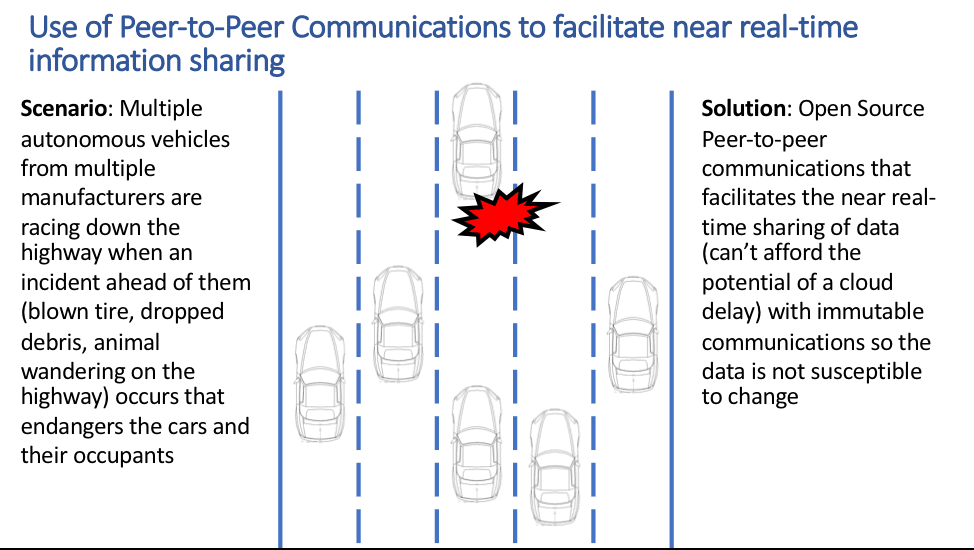My blog “Blockchain + Analytics: Enabling Smart IOT” drew some great feedback asking me to clarify my autonomous vehicle example that used blockchain as a means of near real-time, peer-to-peer communications between clusters of intelligent devices and machines. But first, some background.
Edge analytics within an Internet of Things (IOT) world is very different than traditional big data analytics because it required the ability to stream and analyze massive amounts of real-time data, much of which never changes substantially, outside the confines of the data center or the cloud. The edge enables new monetization opportunities with the ability to capture, analyze and action upon real-time data streaming off the plethora of interconnected devices that comprise an “smart” space such as a factory, hospital, store, stadium, university, mall, home or theme park (see Figure 1).

Figure 1: Monetizing Data and Analytics at the IOT Edge
To support these new monetization opportunities, I introduced the IoT Tiered Analytics Architecture in the blog “Monetizing the Internet of Things (IoT)”. The analytics being performed at the different IoT tiers include (see Figure 2):
- Edge Analytics: real-time, streaming analytics to monitor device or machine performance, flag anomalies, and optimize performance of the individual device or machine. Analytics performed at the edge are event-driven, reactive model execution (not model development) with real-time data compression and decision-making.
- Distributed Analytics: distributed, near-time analytics to optimize performance and utilization of cluster of devices or sensors that comprise a larger community such as a wind farm, building, airplane or oil drilling platform. Analytics performed at the core are localized predictions to drive near-time decisions that optimize group performance and yield using data from the clusters of neighboring devices or sensors.
- Core Analytics: centralized analytics to optimize more strategic business and operational use cases across all tiers. Cloud analytics create predictive and prescriptive analytic models to support more strategic use cases such as demand planning, capacity planning, predictive maintenance, pricing, asset usage optimization and new product introductions. Analytics performed at the cloud process data from all devices plus integrate external data sources to facilitate analytic model development, refinement and continuous learning.

Figure 2: IoT Tiered Analytics Architecture
Analytics + Blockchain = “Smart” IOT
Then in the blog “Blockchain + Analytics: Enabling Smart IOT”, I expanded upon the IoT analytics architecture to highlight where one might want to deploy artificial intelligence technologies – such as reinforcement learning, machine learning and deep learning – across that IoT tiered analytics architecture to support the latency of the decisions across the different levels of the IOT architecture (see Figure 3).

Figure 3: “Blockchain + Analytics: Enabling Smart IOT”
The paragraph that drew the most discussion was the following:
“Autonomous cars are racing down the highway at speeds exceeding 100 MPH when suddenly a car a half-mile ahead blows out a tire sending dangerous debris across 3 lanes of traffic. Instead of relying upon sending this urgent, time-critical distress information to the world via the cloud, the cars on that particular section of the highway use peer-to-peer, immutable communications to inform all vehicles in the area of the danger so that they can slow down and move to unobstructed lanes (while also sending a message to the nearest highway maintenance robots to remove the debris).”
Below is the scenario for which I was contemplating the need for an open peer-to-peer communications capability – like blockchain – to facilitate “conversations” or the sharing of data and information between clusters (swarms[1]?) of smart devices (see Figure 4).

Figure 4: Autonomous Vehicles Using P2P Communications to Share Information
To describe Figure 4:
- The scenario: multiple autonomous vehicles from multiple manufacturers are racing down the highway when an incident ahead of them (blown tire, dropped debris, animal wandering on the highway) occurs that endangers the cars and their occupants
- The solution: anopen, distributed Peer-to-Peer (P2P) communications that facilitates the near real-time sharing of data (can’t afford the potential of a cloud delay) with immutability so the data is not susceptible to change
And the information that could be shared in the real-time conversations between the autonomous vehicles might go beyond just potential dangers in the road ahead, and could include information such as road conditions (potholes, emergency road maintenance, slow machinery on the roads), real-time traffic routing optimization, or even recommended restaurants, coffee shops and hotels near the highway. Heck, a marketplace could be created that rewards entities for sharing accurate and relevant data (enabled via Bitcoin?).
Am I Looking too Far Into the Future?
I have also gotten feedback about the economic infeasibility of using blockchain as this peer-to-peer network. But betting against the drop in costs and increases in storage and compute at the edge might be the wrong bet. Could the combination of blockchain and the increasing computational power at the edge not only make blockchain suitable for these types of IoT situations, but also create virtual cloud environments that make today’s dominate cloud players irrelevant?
Disruption happens when no one is looking; when a technology that we have taken as an absolute (like the cloud) gets blindsided by a new technology. That’s when billionaires get created.
I guess I’m have to embrace my inner Doc Brown and jump “Back to The Future” to find out…

[1]Swarms are independent, heterogeneous, connected IoT devices that can cooperat…. Yes, basically the end of the world as we know it.
